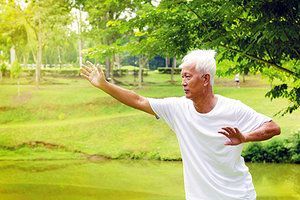One of the longest nerves in the body is known as the vagus nerve (VN). The VN is the 10th pair of cranial nerves that originates at the brain stem in the medulla oblongata. This nerve is part of the parasympathetic nervous system, which is a part of the ANS. Research suggests ear acupuncture can activate the VN.
Medical Qigong for the Heart: Part I
Editor's Note: This is part 1 of a 3 part series that will focus on how medical qi gong can benefit the physical, mental-emotional and spiritual aspects of the heart.
According to the Center for Disease Control and Prevention, heart disease is the leading cause of death in the United States, affecting people of all ages and backgrounds. Coronary heart disease, in just the United States alone, costs close to 109 billion dollars a year.
The earliest qi gong came from the Chinese observing the movement of animals. By imitating the movement of a bird flapping its wings, we can bring enormous health benefits to the heart. All Medical qi gong has three aspects: posture, breath and intentionality.
Posture
The bird flaps its wing qi gong should be done in both a vertical plane as well as a horizontal plane. In qi gong, all movements are very relaxed, so there should no tension in the arms and the elbows and wrists should be loose. Make sure that your shoulders stay relaxed.
In the vertical plane, start from a normal standing position with arms by the side. Then stretch up, circling the arms out to the side with palms facing down to above the head. Hands do not touch. The sternum should rise and lift the chest as the arms move up. As the arms move down, the sternum compresses and the chest hollows. We want full body participation, so as the arms come back down and the sternum compresses also bend the knees. The knees straighten as you stretch back up again to repeat the exercise.

In the horizontal plane, the arms are placed in front of the torso at heart level with elbows bent and palms facing down. As the arms move out to the side, the sternum lifts, the knees bend. As the arms reach the sides of the body, rotate the palms to face upward. As your arms return to the starting position, the sternum compresses inward to hollow the chest, and the knees straighten.
Hands do not touch when returning to the starting position. Lifting and compressing the sternum will massage the heart and will result in increased blood circulation to the organs. Although this posture is done in the Daoist 5 yin organ series for the lung, it also has tremendous benefit for the heart. The heart and lungs are neighbors, so all upper body movement that expand the muscles of the chest will also open the lungs and help oxygenate the body. The pumping action of the bending and straightening of the knees and the rising and falling of the thoracic region benefit lymphatic circulation.
Breath
This is a regulating qi gong, so the breath should be equal on the inhale and exhale. Inhale deeply on each movement where the sternum rises and exhale on each movement as the sternum falls.
This is a natural breath, which means especially the upper thoracic region but also the abdomen expand on the inhale and contract on the exhale. Natural thoracic breathing will stimulate qi and blood flow to both the lungs and the heart as well as strengthen the immune system.
Intention
Let your mind focus on your heart. It is always a good idea if a qi gong exercise has a organ intentionality to have your mind focused on that particular organ while performing that exercise.
The heart's virtue is peace and order. As the emperor of our human body, what more could an emperor want for his kingdom then peace and order! If your life is currently tumultuous or you find peace difficult, then smile while performing this exercise.
According to a study reported in Association for Psychological Science, a smile can benefit your heart health. The research showed that participants who were able to have a genuine smile where both the muscles of the mouth and the eyes were involved had lower heart rates after stressful activities than participants who held their face in a neutral position or were smiling only with the mouth muscles. Resting your mind on your heart and feeling peaceful and smiling will definitely increase the health benefits of this heart-centered qi gong.
Conclusion
All three components of this medical qi gong exercise work together to create optimal heart health. This exercise can be done for 5 –10 minutes daily or for as long as it feels comfortable. If you experience any difficulties or have any health concerns, please check with your doctor prior to performing. The ease of the exercise means that it can be done by people who are elderly, overweight or even wheel-chair bound. Finally, although not scientifically proven, it has been speculated that the longevity and vitality of orchestra conductors, both physically and mentally, is due to their extensive arm waving movements done while performing.
Resources
- Center for Disease Control: [url=http://www.cdc.gov/heartdisease/statistics.html]http://www.cdc.gov/heartdisease/statistics.html[/url]
- Chinese Medical Qigong Therapy Volume 4: Prescription Exercises and Meditations,
Treatment of Internal Diseases, Pediatrics, Geriatrics, Gynceology, Neurology and Energetic
Psychology (pages 140-142) By Professor Jerry Alan Johnson - Association for Psychological Science:
[url=http://www.psychologicalscience.org/index.php/news/stress-busting-smiles.html]http://www.psychologicalscience.org/index.php/news/stress-busting-smiles.html[/url]



